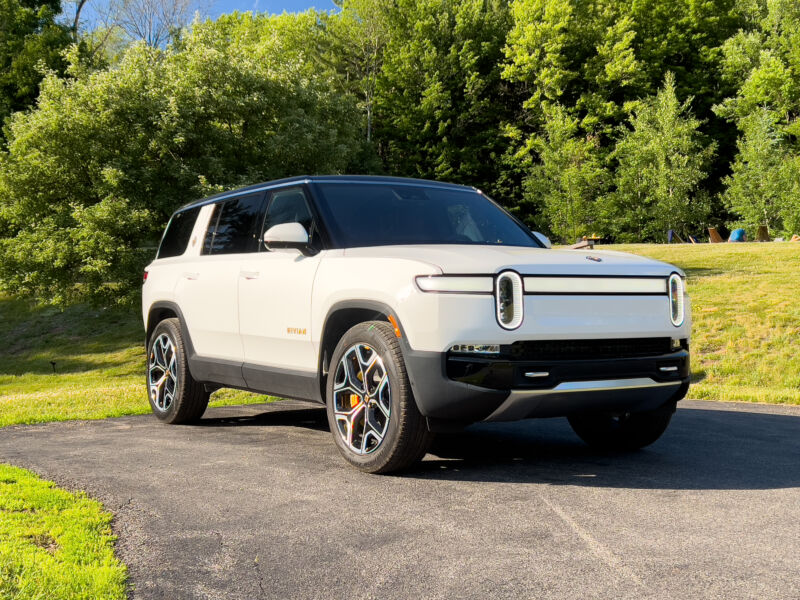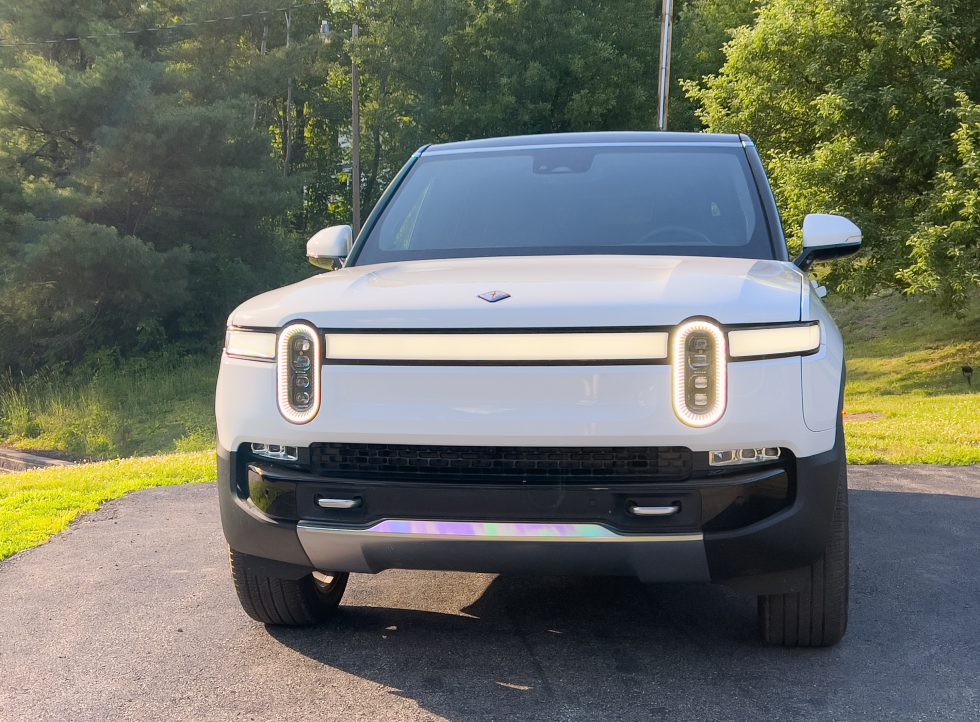
Last September, we drove one of Rivian's new electric trucks and found its R1 platform highly competent on and off the road, with an impressive level of engineering that made driving to the top of a mountain almost effortless. It's been a tough few months for the electric vehicle maker since then, with supply chain issues delaying deliveries, a former executive filing a discrimination lawsuit, and shareholders upset about a rather clumsy price hike.
But Rivian remains very well-funded, and its factory in Normal, Illinois, is finding its feet building electric trucks as well as delivery vans for Amazon. Now another R1-based EV is entering production—the R1S SUV.
Like its truck sibling, the R1S is a friendly looking thing, particularly compared to the more aggressive SUVs coming out of Detroit. Partly that's down to the design of the lights, which should set off your pareidolia, and partly down to what now passes for a relatively low hood height, with curved edges finding favor over sharp creases at the corners.

That said, the R1S remains a large SUV. It's the same width (81.8 inches/2,078 mm) as the R1T truck, but at 200.8 inches (5,100 mm) long the R1S is actually 16.3 inches (414 mm) shorter, with most of that difference (14.7 inches/374 mm) coming out of the wheelbase. As a consequence, there's no longer a gear tunnel—the innovative cargo area that lives just below and behind the R1T's rear seats—but you do get a third row of seats that fold flat with the floor when not in use.
Under the hood, there's a large powered frunk, just like on the R1T, with 11 cubic feet (313 L) of storage space. Open the split tailgate—the lower portion can support up to 1,000 lbs (454 kg), so feel free to sit on it—and there's a useful 17.6 cubic feet (498 L) of cargo capacity that increases to a capacious 46.7 cubic feet (1,322 L) if you don't need to employ the third-row seating. For really big loads, fold down the middle row as well and enjoy 88.2 cubic feet (2,498 L) of cargo capacity.
As with the truck, the interior is a stylish place to be. I'm a particular fan of the recycled wood trim, as well as the thoughtful approach Rivian took to placing USB-C ports and storage areas. Visibility from the driver's seat is good, without too many blindspots, but some readers might be turned off by an all-touchscreen user interface for the infotainment system and the lack of Apple CarPlay and Android Auto support.
-
This is a button-free zone, but there are plenty of USB ports and places to store your stuff. It could use grab handles and a retractable sunshade, though.Jonathan Gitlin
-
The middle row of seats is split 40:20:40 and moves forward and back. Even with this row all the way back there's room in the third row, although, like all third rows, your feet are quite close to your hips.Jonathan Gitlin
-
There's an extra 5-cubic-foot storage area underneath the floor.Jonathan Gitlin
The cabin could do with grab handles to make it easier to climb aboard, and yet again an automaker has created an EV with a full-length glass roof that has no sunshade. Rivian says that the panoramic glass blocks 99.9 percent of UV rays as well as heat, but it would be nice to have some retractable fabric that could just block it all when the owner desires. A passenger sitting in the middle row on the right side of the car might also be dazzled by reflections off the main instrument display, as I discovered.
The family resemblance between truck and SUV is more than just skin deep; mechanically, the R1S that we drove in New York is basically the same as the R1T we drove in 2021. Our test R1S featured the 835 hp (623 kW), 908 lb-ft (1,231 Nm) quad-motor configuration, paired with the 135-kWh battery pack.
The front drive unit generates 415 hp (310 kW) and 413 lb-ft (560 Nm), with the rear drive unit contributing 420 hp (313 kW) and 495 lb-ft (671 Nm). Each drive unit contains two motors, one for each wheel, so the powertrain doesn't require a conventional differential to apportion torque from one side to the other.
reader comments
379